Analysis of Digital Communication Strategy Within an Organization
VerifiedAdded on 2023/06/10
|12
|2711
|352
Report
AI Summary
This report provides an analysis of digital communication strategies within an organization, drawing on ten academic journals and articles. The report examines the implementation of digital communication tools to boost workplace motivation and the use of social media for communication. Each article is summarized and critically evaluated, highlighting the methodologies used, key findings, and limitations. The report discusses the impact of digital technology on innovation, the role of social media, and the challenges and opportunities associated with these tools. The analysis considers factors such as employee behavior, knowledge management, and the implications of digital communication on organizational performance and employee creativity. The conclusion summarizes the key insights and emphasizes the importance of strategic digital communication for organizational success, referencing various academic resources.
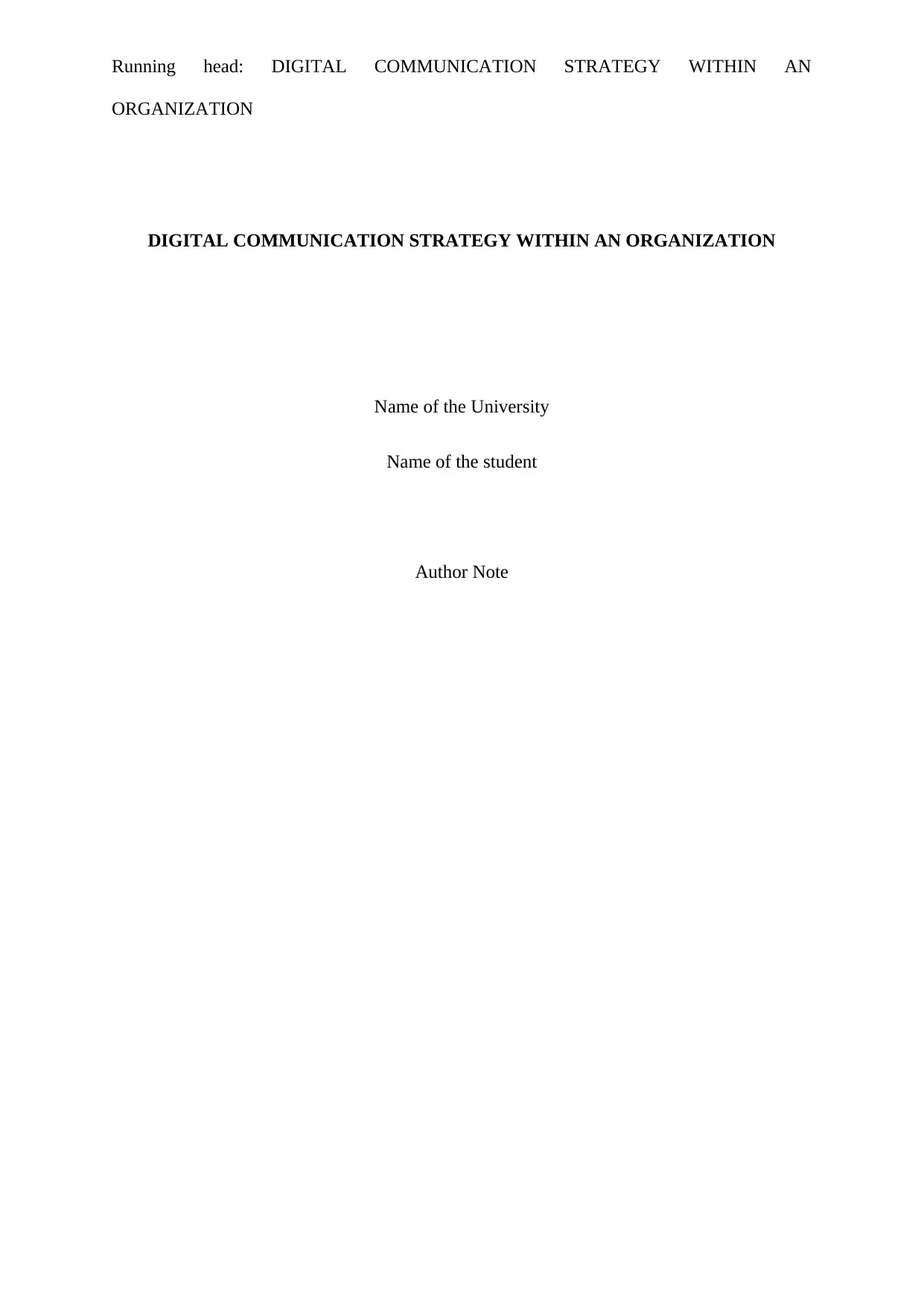
Running head: DIGITAL COMMUNICATION STRATEGY WITHIN AN
ORGANIZATION
DIGITAL COMMUNICATION STRATEGY WITHIN AN ORGANIZATION
Name of the University
Name of the student
Author Note
ORGANIZATION
DIGITAL COMMUNICATION STRATEGY WITHIN AN ORGANIZATION
Name of the University
Name of the student
Author Note
Paraphrase This Document
Need a fresh take? Get an instant paraphrase of this document with our AI Paraphraser
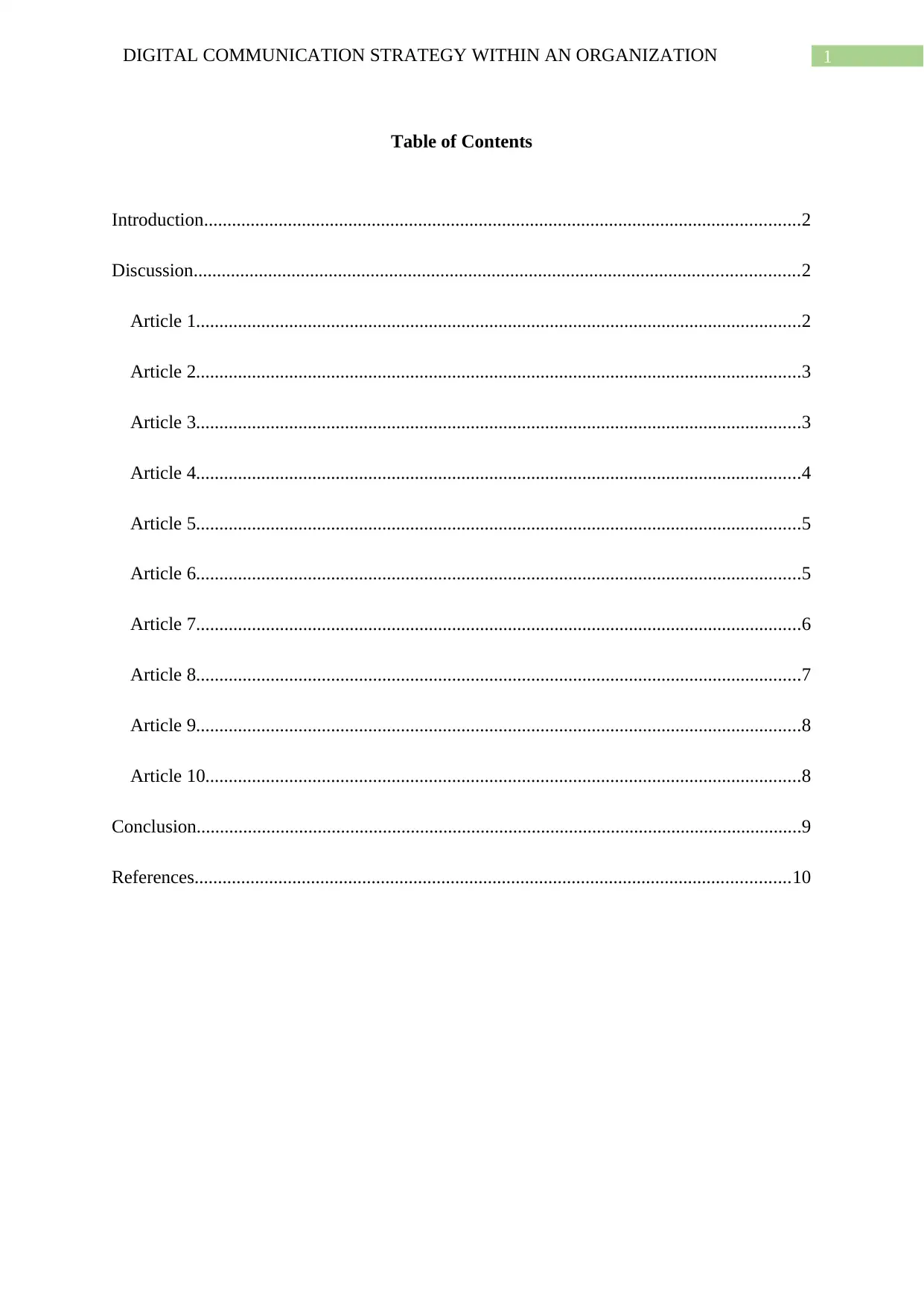
1DIGITAL COMMUNICATION STRATEGY WITHIN AN ORGANIZATION
Table of Contents
Introduction................................................................................................................................2
Discussion..................................................................................................................................2
Article 1..................................................................................................................................2
Article 2..................................................................................................................................3
Article 3..................................................................................................................................3
Article 4..................................................................................................................................4
Article 5..................................................................................................................................5
Article 6..................................................................................................................................5
Article 7..................................................................................................................................6
Article 8..................................................................................................................................7
Article 9..................................................................................................................................8
Article 10................................................................................................................................8
Conclusion..................................................................................................................................9
References................................................................................................................................10
Table of Contents
Introduction................................................................................................................................2
Discussion..................................................................................................................................2
Article 1..................................................................................................................................2
Article 2..................................................................................................................................3
Article 3..................................................................................................................................3
Article 4..................................................................................................................................4
Article 5..................................................................................................................................5
Article 6..................................................................................................................................5
Article 7..................................................................................................................................6
Article 8..................................................................................................................................7
Article 9..................................................................................................................................8
Article 10................................................................................................................................8
Conclusion..................................................................................................................................9
References................................................................................................................................10
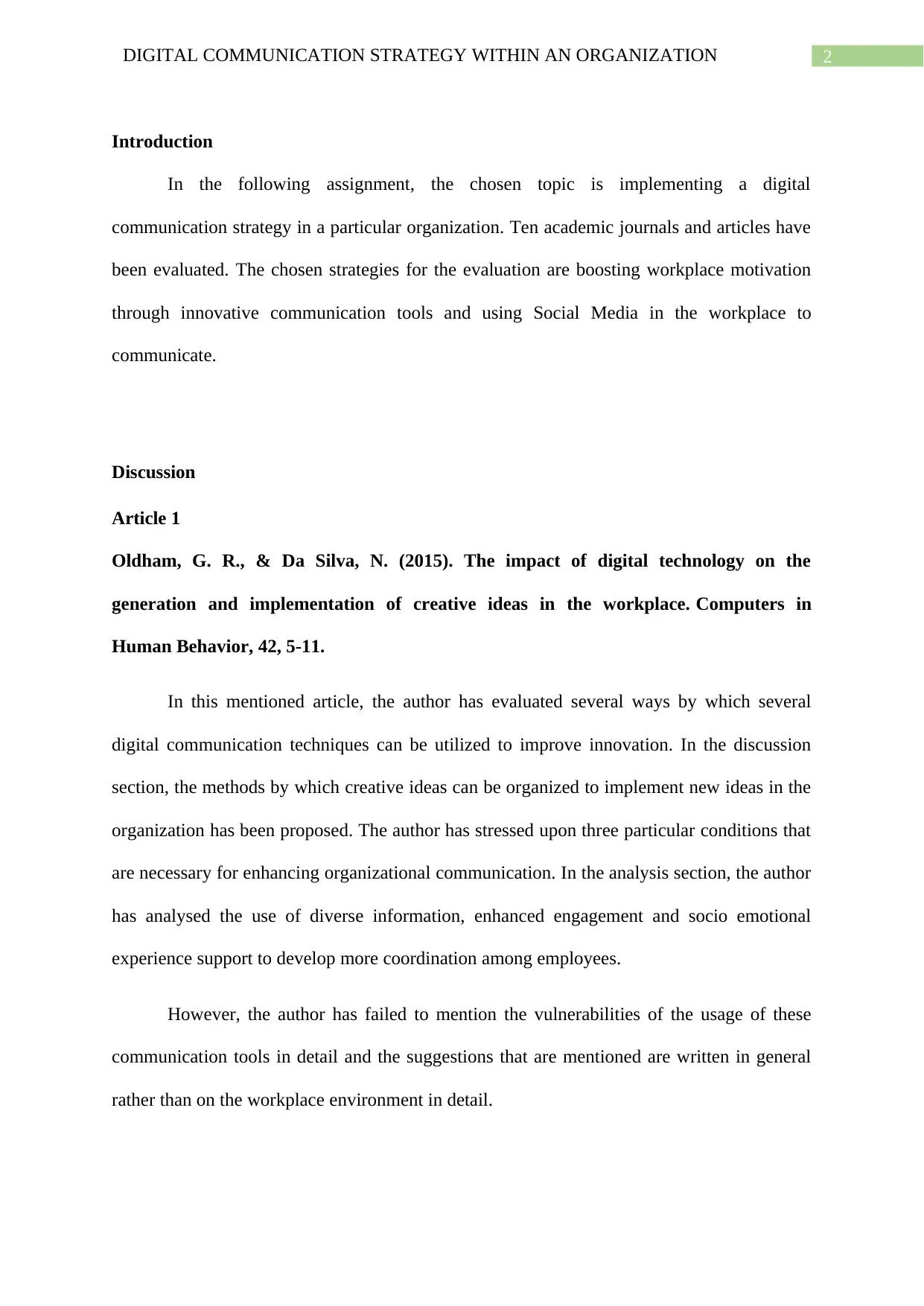
2DIGITAL COMMUNICATION STRATEGY WITHIN AN ORGANIZATION
Introduction
In the following assignment, the chosen topic is implementing a digital
communication strategy in a particular organization. Ten academic journals and articles have
been evaluated. The chosen strategies for the evaluation are boosting workplace motivation
through innovative communication tools and using Social Media in the workplace to
communicate.
Discussion
Article 1
Oldham, G. R., & Da Silva, N. (2015). The impact of digital technology on the
generation and implementation of creative ideas in the workplace. Computers in
Human Behavior, 42, 5-11.
In this mentioned article, the author has evaluated several ways by which several
digital communication techniques can be utilized to improve innovation. In the discussion
section, the methods by which creative ideas can be organized to implement new ideas in the
organization has been proposed. The author has stressed upon three particular conditions that
are necessary for enhancing organizational communication. In the analysis section, the author
has analysed the use of diverse information, enhanced engagement and socio emotional
experience support to develop more coordination among employees.
However, the author has failed to mention the vulnerabilities of the usage of these
communication tools in detail and the suggestions that are mentioned are written in general
rather than on the workplace environment in detail.
Introduction
In the following assignment, the chosen topic is implementing a digital
communication strategy in a particular organization. Ten academic journals and articles have
been evaluated. The chosen strategies for the evaluation are boosting workplace motivation
through innovative communication tools and using Social Media in the workplace to
communicate.
Discussion
Article 1
Oldham, G. R., & Da Silva, N. (2015). The impact of digital technology on the
generation and implementation of creative ideas in the workplace. Computers in
Human Behavior, 42, 5-11.
In this mentioned article, the author has evaluated several ways by which several
digital communication techniques can be utilized to improve innovation. In the discussion
section, the methods by which creative ideas can be organized to implement new ideas in the
organization has been proposed. The author has stressed upon three particular conditions that
are necessary for enhancing organizational communication. In the analysis section, the author
has analysed the use of diverse information, enhanced engagement and socio emotional
experience support to develop more coordination among employees.
However, the author has failed to mention the vulnerabilities of the usage of these
communication tools in detail and the suggestions that are mentioned are written in general
rather than on the workplace environment in detail.
⊘ This is a preview!⊘
Do you want full access?
Subscribe today to unlock all pages.

Trusted by 1+ million students worldwide
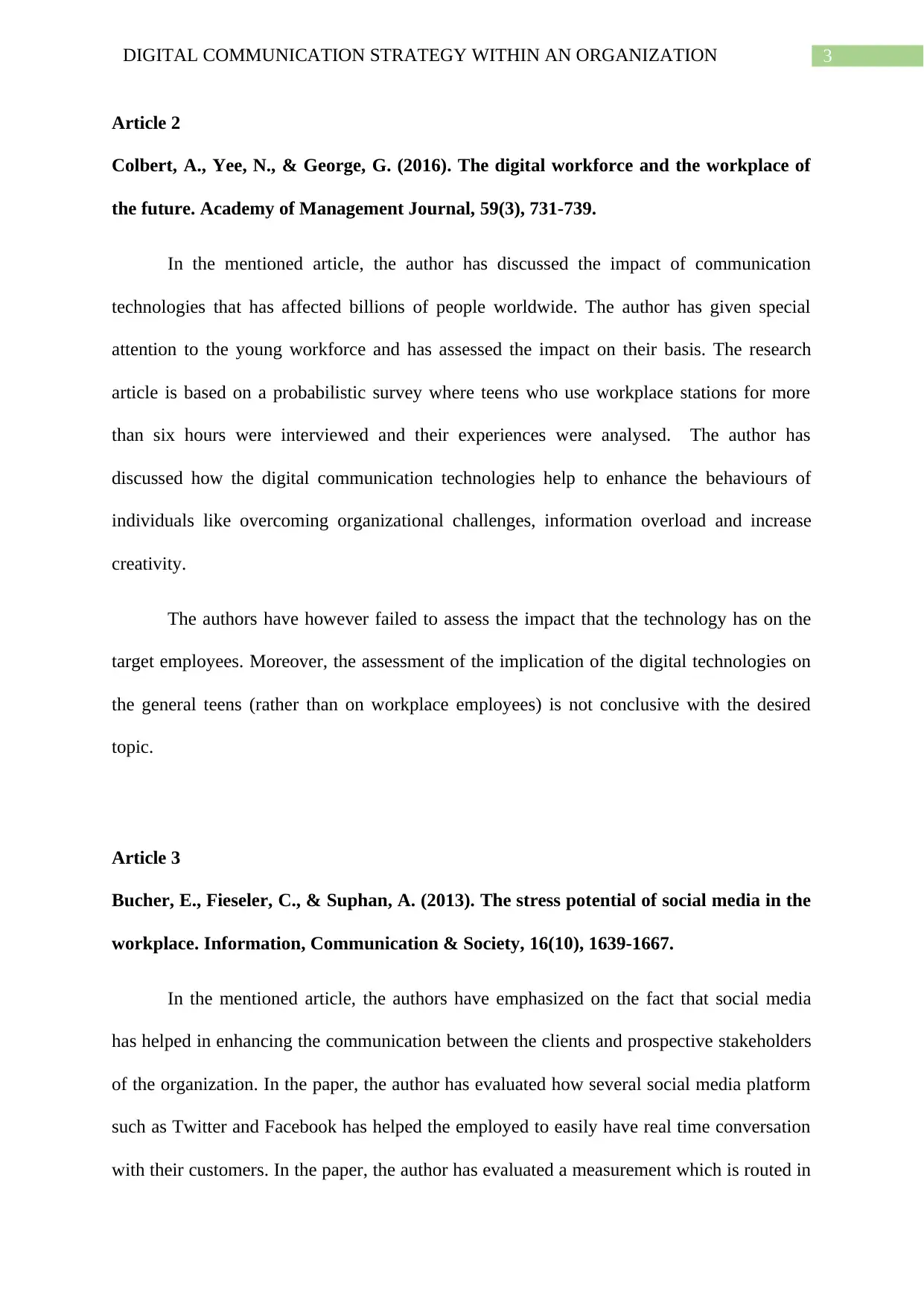
3DIGITAL COMMUNICATION STRATEGY WITHIN AN ORGANIZATION
Article 2
Colbert, A., Yee, N., & George, G. (2016). The digital workforce and the workplace of
the future. Academy of Management Journal, 59(3), 731-739.
In the mentioned article, the author has discussed the impact of communication
technologies that has affected billions of people worldwide. The author has given special
attention to the young workforce and has assessed the impact on their basis. The research
article is based on a probabilistic survey where teens who use workplace stations for more
than six hours were interviewed and their experiences were analysed. The author has
discussed how the digital communication technologies help to enhance the behaviours of
individuals like overcoming organizational challenges, information overload and increase
creativity.
The authors have however failed to assess the impact that the technology has on the
target employees. Moreover, the assessment of the implication of the digital technologies on
the general teens (rather than on workplace employees) is not conclusive with the desired
topic.
Article 3
Bucher, E., Fieseler, C., & Suphan, A. (2013). The stress potential of social media in the
workplace. Information, Communication & Society, 16(10), 1639-1667.
In the mentioned article, the authors have emphasized on the fact that social media
has helped in enhancing the communication between the clients and prospective stakeholders
of the organization. In the paper, the author has evaluated how several social media platform
such as Twitter and Facebook has helped the employed to easily have real time conversation
with their customers. In the paper, the author has evaluated a measurement which is routed in
Article 2
Colbert, A., Yee, N., & George, G. (2016). The digital workforce and the workplace of
the future. Academy of Management Journal, 59(3), 731-739.
In the mentioned article, the author has discussed the impact of communication
technologies that has affected billions of people worldwide. The author has given special
attention to the young workforce and has assessed the impact on their basis. The research
article is based on a probabilistic survey where teens who use workplace stations for more
than six hours were interviewed and their experiences were analysed. The author has
discussed how the digital communication technologies help to enhance the behaviours of
individuals like overcoming organizational challenges, information overload and increase
creativity.
The authors have however failed to assess the impact that the technology has on the
target employees. Moreover, the assessment of the implication of the digital technologies on
the general teens (rather than on workplace employees) is not conclusive with the desired
topic.
Article 3
Bucher, E., Fieseler, C., & Suphan, A. (2013). The stress potential of social media in the
workplace. Information, Communication & Society, 16(10), 1639-1667.
In the mentioned article, the authors have emphasized on the fact that social media
has helped in enhancing the communication between the clients and prospective stakeholders
of the organization. In the paper, the author has evaluated how several social media platform
such as Twitter and Facebook has helped the employed to easily have real time conversation
with their customers. In the paper, the author has evaluated a measurement which is routed in
Paraphrase This Document
Need a fresh take? Get an instant paraphrase of this document with our AI Paraphraser
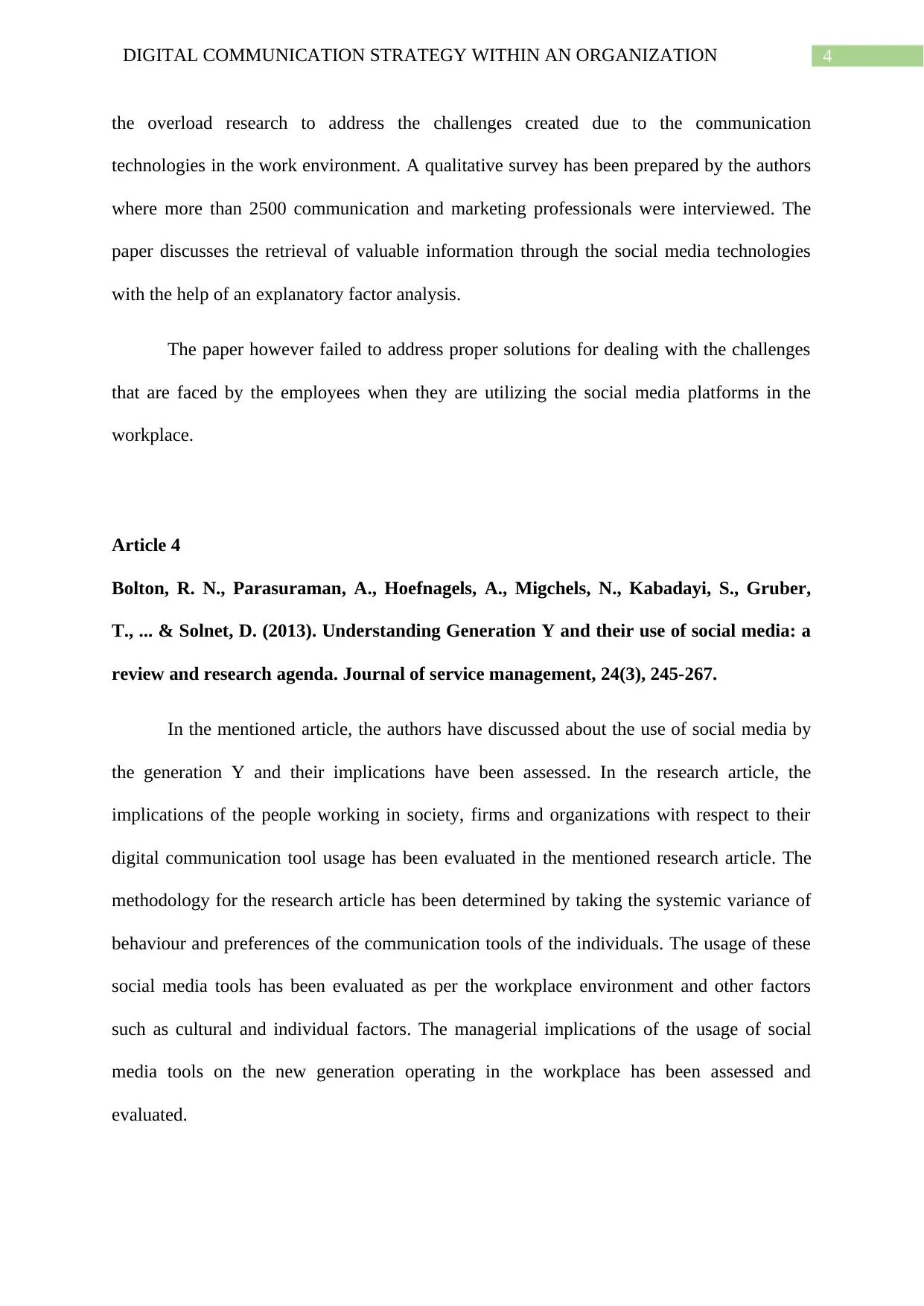
4DIGITAL COMMUNICATION STRATEGY WITHIN AN ORGANIZATION
the overload research to address the challenges created due to the communication
technologies in the work environment. A qualitative survey has been prepared by the authors
where more than 2500 communication and marketing professionals were interviewed. The
paper discusses the retrieval of valuable information through the social media technologies
with the help of an explanatory factor analysis.
The paper however failed to address proper solutions for dealing with the challenges
that are faced by the employees when they are utilizing the social media platforms in the
workplace.
Article 4
Bolton, R. N., Parasuraman, A., Hoefnagels, A., Migchels, N., Kabadayi, S., Gruber,
T., ... & Solnet, D. (2013). Understanding Generation Y and their use of social media: a
review and research agenda. Journal of service management, 24(3), 245-267.
In the mentioned article, the authors have discussed about the use of social media by
the generation Y and their implications have been assessed. In the research article, the
implications of the people working in society, firms and organizations with respect to their
digital communication tool usage has been evaluated in the mentioned research article. The
methodology for the research article has been determined by taking the systemic variance of
behaviour and preferences of the communication tools of the individuals. The usage of these
social media tools has been evaluated as per the workplace environment and other factors
such as cultural and individual factors. The managerial implications of the usage of social
media tools on the new generation operating in the workplace has been assessed and
evaluated.
the overload research to address the challenges created due to the communication
technologies in the work environment. A qualitative survey has been prepared by the authors
where more than 2500 communication and marketing professionals were interviewed. The
paper discusses the retrieval of valuable information through the social media technologies
with the help of an explanatory factor analysis.
The paper however failed to address proper solutions for dealing with the challenges
that are faced by the employees when they are utilizing the social media platforms in the
workplace.
Article 4
Bolton, R. N., Parasuraman, A., Hoefnagels, A., Migchels, N., Kabadayi, S., Gruber,
T., ... & Solnet, D. (2013). Understanding Generation Y and their use of social media: a
review and research agenda. Journal of service management, 24(3), 245-267.
In the mentioned article, the authors have discussed about the use of social media by
the generation Y and their implications have been assessed. In the research article, the
implications of the people working in society, firms and organizations with respect to their
digital communication tool usage has been evaluated in the mentioned research article. The
methodology for the research article has been determined by taking the systemic variance of
behaviour and preferences of the communication tools of the individuals. The usage of these
social media tools has been evaluated as per the workplace environment and other factors
such as cultural and individual factors. The managerial implications of the usage of social
media tools on the new generation operating in the workplace has been assessed and
evaluated.
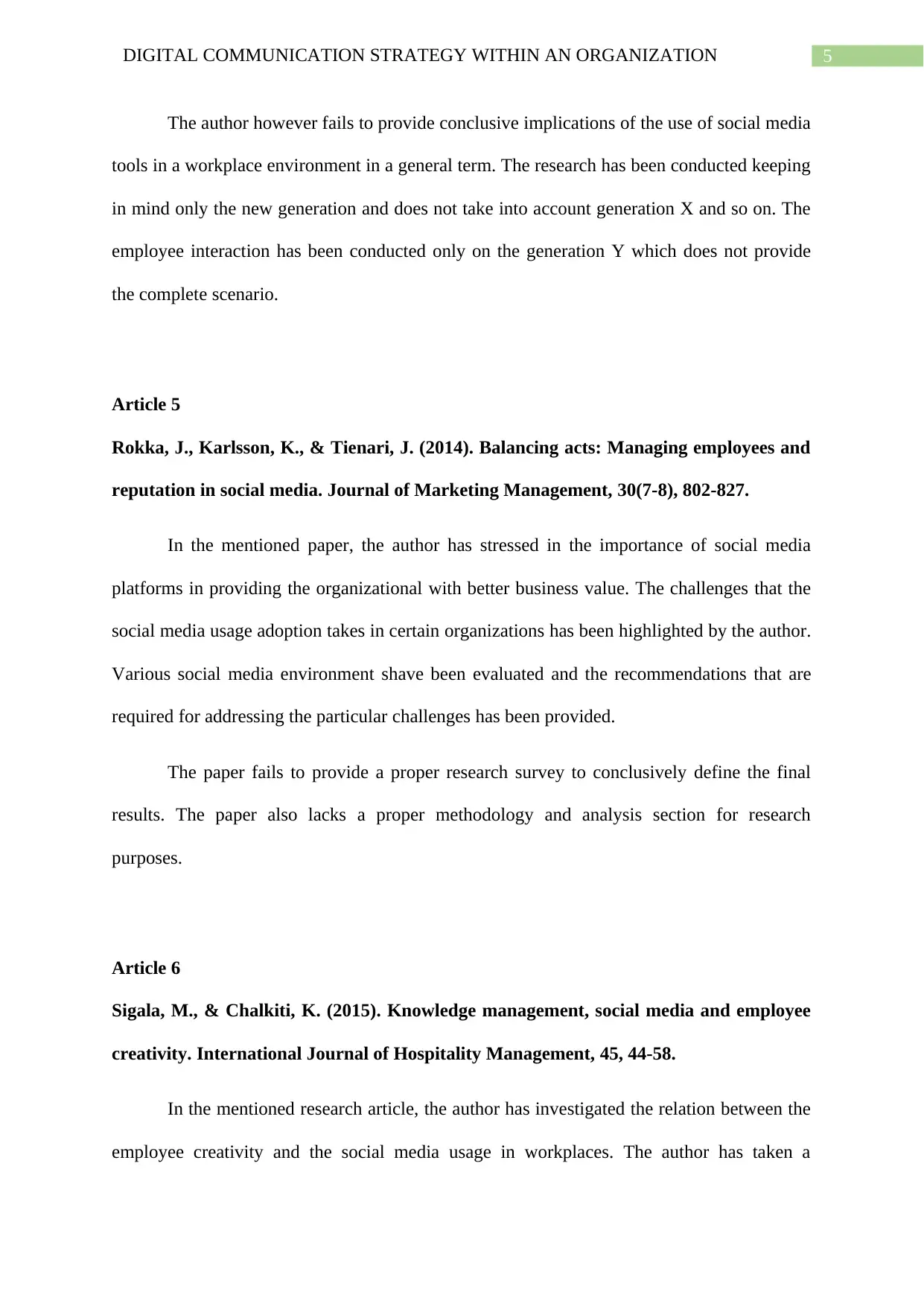
5DIGITAL COMMUNICATION STRATEGY WITHIN AN ORGANIZATION
The author however fails to provide conclusive implications of the use of social media
tools in a workplace environment in a general term. The research has been conducted keeping
in mind only the new generation and does not take into account generation X and so on. The
employee interaction has been conducted only on the generation Y which does not provide
the complete scenario.
Article 5
Rokka, J., Karlsson, K., & Tienari, J. (2014). Balancing acts: Managing employees and
reputation in social media. Journal of Marketing Management, 30(7-8), 802-827.
In the mentioned paper, the author has stressed in the importance of social media
platforms in providing the organizational with better business value. The challenges that the
social media usage adoption takes in certain organizations has been highlighted by the author.
Various social media environment shave been evaluated and the recommendations that are
required for addressing the particular challenges has been provided.
The paper fails to provide a proper research survey to conclusively define the final
results. The paper also lacks a proper methodology and analysis section for research
purposes.
Article 6
Sigala, M., & Chalkiti, K. (2015). Knowledge management, social media and employee
creativity. International Journal of Hospitality Management, 45, 44-58.
In the mentioned research article, the author has investigated the relation between the
employee creativity and the social media usage in workplaces. The author has taken a
The author however fails to provide conclusive implications of the use of social media
tools in a workplace environment in a general term. The research has been conducted keeping
in mind only the new generation and does not take into account generation X and so on. The
employee interaction has been conducted only on the generation Y which does not provide
the complete scenario.
Article 5
Rokka, J., Karlsson, K., & Tienari, J. (2014). Balancing acts: Managing employees and
reputation in social media. Journal of Marketing Management, 30(7-8), 802-827.
In the mentioned paper, the author has stressed in the importance of social media
platforms in providing the organizational with better business value. The challenges that the
social media usage adoption takes in certain organizations has been highlighted by the author.
Various social media environment shave been evaluated and the recommendations that are
required for addressing the particular challenges has been provided.
The paper fails to provide a proper research survey to conclusively define the final
results. The paper also lacks a proper methodology and analysis section for research
purposes.
Article 6
Sigala, M., & Chalkiti, K. (2015). Knowledge management, social media and employee
creativity. International Journal of Hospitality Management, 45, 44-58.
In the mentioned research article, the author has investigated the relation between the
employee creativity and the social media usage in workplaces. The author has taken a
⊘ This is a preview!⊘
Do you want full access?
Subscribe today to unlock all pages.

Trusted by 1+ million students worldwide
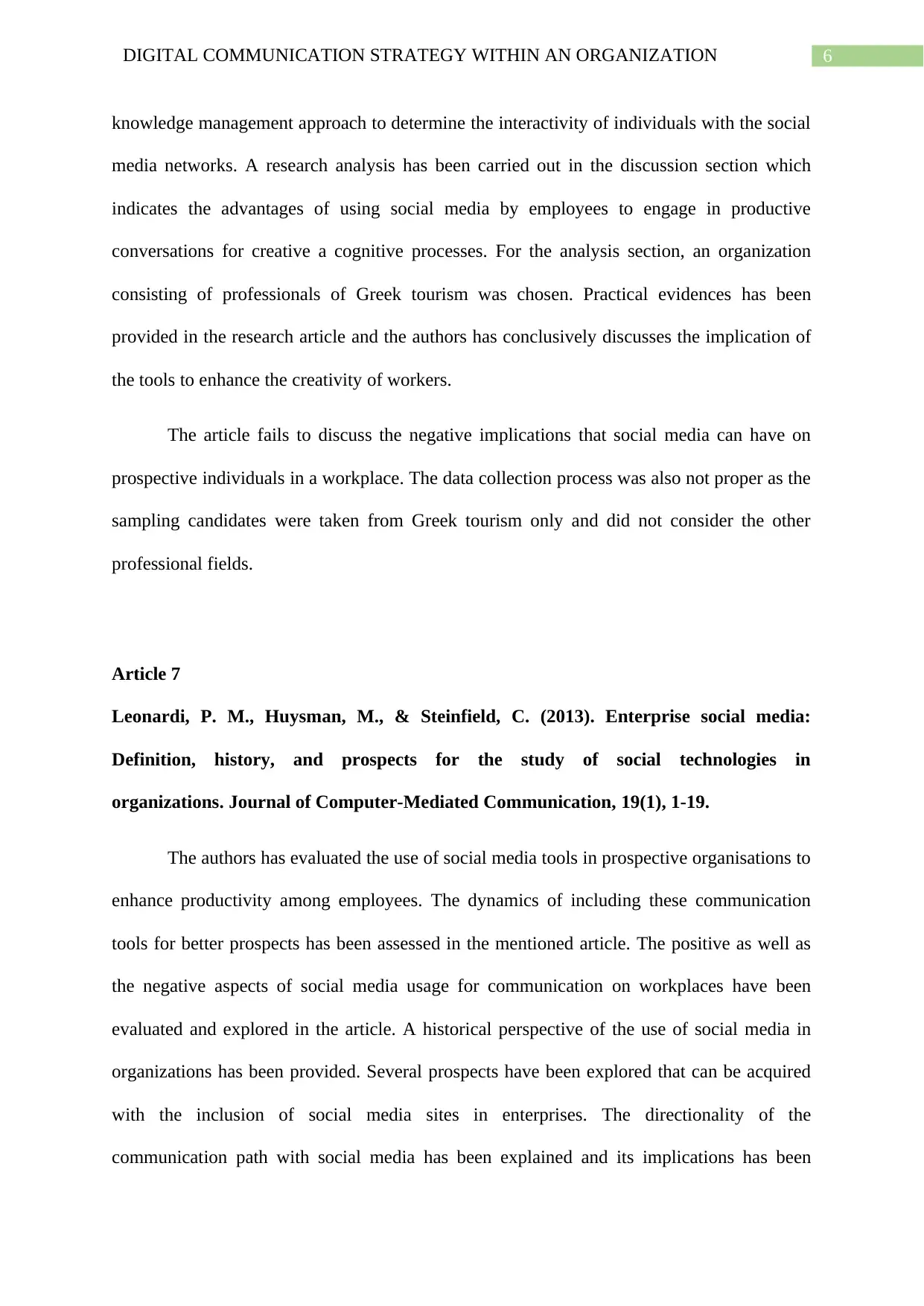
6DIGITAL COMMUNICATION STRATEGY WITHIN AN ORGANIZATION
knowledge management approach to determine the interactivity of individuals with the social
media networks. A research analysis has been carried out in the discussion section which
indicates the advantages of using social media by employees to engage in productive
conversations for creative a cognitive processes. For the analysis section, an organization
consisting of professionals of Greek tourism was chosen. Practical evidences has been
provided in the research article and the authors has conclusively discusses the implication of
the tools to enhance the creativity of workers.
The article fails to discuss the negative implications that social media can have on
prospective individuals in a workplace. The data collection process was also not proper as the
sampling candidates were taken from Greek tourism only and did not consider the other
professional fields.
Article 7
Leonardi, P. M., Huysman, M., & Steinfield, C. (2013). Enterprise social media:
Definition, history, and prospects for the study of social technologies in
organizations. Journal of Computer-Mediated Communication, 19(1), 1-19.
The authors has evaluated the use of social media tools in prospective organisations to
enhance productivity among employees. The dynamics of including these communication
tools for better prospects has been assessed in the mentioned article. The positive as well as
the negative aspects of social media usage for communication on workplaces have been
evaluated and explored in the article. A historical perspective of the use of social media in
organizations has been provided. Several prospects have been explored that can be acquired
with the inclusion of social media sites in enterprises. The directionality of the
communication path with social media has been explained and its implications has been
knowledge management approach to determine the interactivity of individuals with the social
media networks. A research analysis has been carried out in the discussion section which
indicates the advantages of using social media by employees to engage in productive
conversations for creative a cognitive processes. For the analysis section, an organization
consisting of professionals of Greek tourism was chosen. Practical evidences has been
provided in the research article and the authors has conclusively discusses the implication of
the tools to enhance the creativity of workers.
The article fails to discuss the negative implications that social media can have on
prospective individuals in a workplace. The data collection process was also not proper as the
sampling candidates were taken from Greek tourism only and did not consider the other
professional fields.
Article 7
Leonardi, P. M., Huysman, M., & Steinfield, C. (2013). Enterprise social media:
Definition, history, and prospects for the study of social technologies in
organizations. Journal of Computer-Mediated Communication, 19(1), 1-19.
The authors has evaluated the use of social media tools in prospective organisations to
enhance productivity among employees. The dynamics of including these communication
tools for better prospects has been assessed in the mentioned article. The positive as well as
the negative aspects of social media usage for communication on workplaces have been
evaluated and explored in the article. A historical perspective of the use of social media in
organizations has been provided. Several prospects have been explored that can be acquired
with the inclusion of social media sites in enterprises. The directionality of the
communication path with social media has been explained and its implications has been
Paraphrase This Document
Need a fresh take? Get an instant paraphrase of this document with our AI Paraphraser
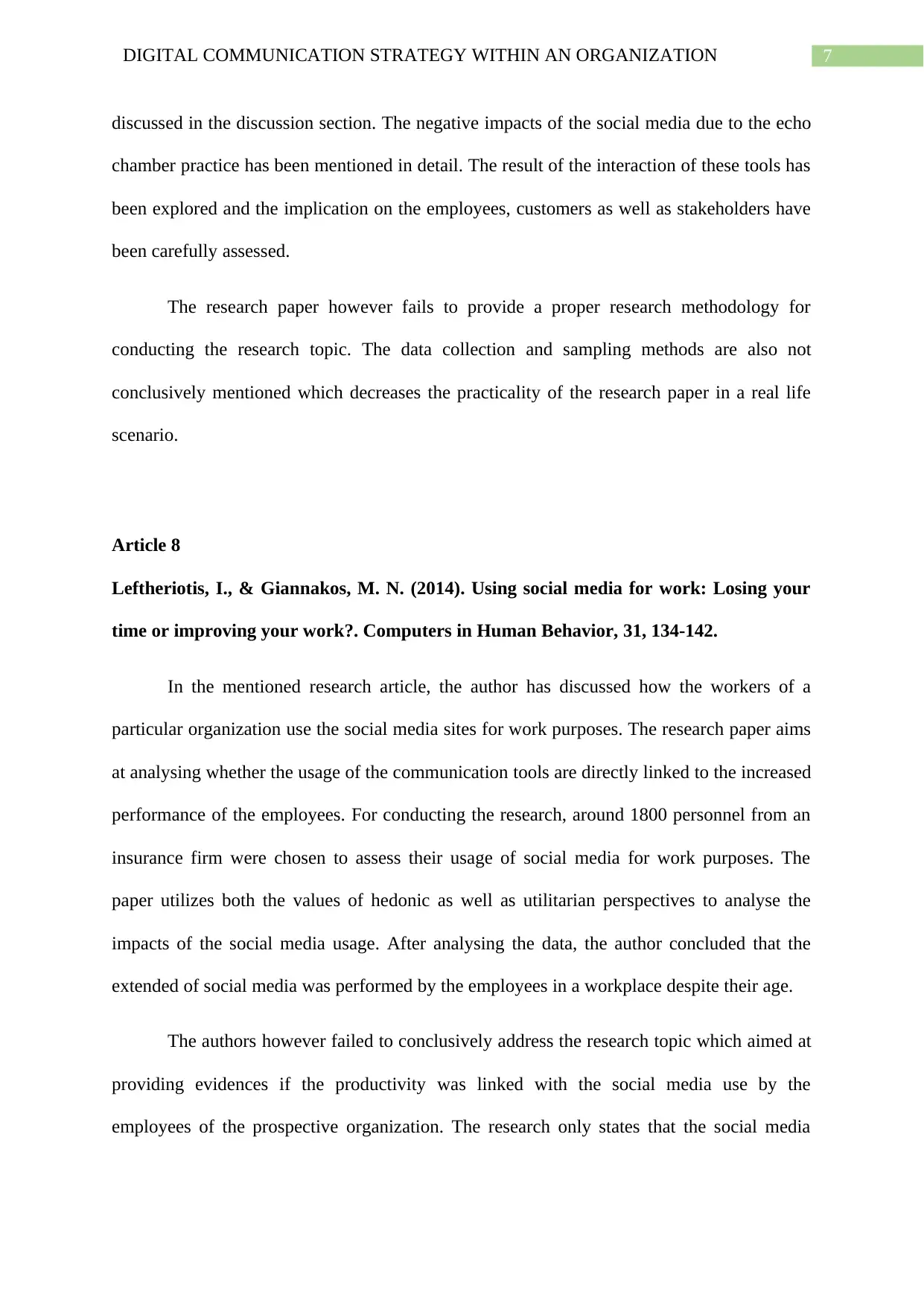
7DIGITAL COMMUNICATION STRATEGY WITHIN AN ORGANIZATION
discussed in the discussion section. The negative impacts of the social media due to the echo
chamber practice has been mentioned in detail. The result of the interaction of these tools has
been explored and the implication on the employees, customers as well as stakeholders have
been carefully assessed.
The research paper however fails to provide a proper research methodology for
conducting the research topic. The data collection and sampling methods are also not
conclusively mentioned which decreases the practicality of the research paper in a real life
scenario.
Article 8
Leftheriotis, I., & Giannakos, M. N. (2014). Using social media for work: Losing your
time or improving your work?. Computers in Human Behavior, 31, 134-142.
In the mentioned research article, the author has discussed how the workers of a
particular organization use the social media sites for work purposes. The research paper aims
at analysing whether the usage of the communication tools are directly linked to the increased
performance of the employees. For conducting the research, around 1800 personnel from an
insurance firm were chosen to assess their usage of social media for work purposes. The
paper utilizes both the values of hedonic as well as utilitarian perspectives to analyse the
impacts of the social media usage. After analysing the data, the author concluded that the
extended of social media was performed by the employees in a workplace despite their age.
The authors however failed to conclusively address the research topic which aimed at
providing evidences if the productivity was linked with the social media use by the
employees of the prospective organization. The research only states that the social media
discussed in the discussion section. The negative impacts of the social media due to the echo
chamber practice has been mentioned in detail. The result of the interaction of these tools has
been explored and the implication on the employees, customers as well as stakeholders have
been carefully assessed.
The research paper however fails to provide a proper research methodology for
conducting the research topic. The data collection and sampling methods are also not
conclusively mentioned which decreases the practicality of the research paper in a real life
scenario.
Article 8
Leftheriotis, I., & Giannakos, M. N. (2014). Using social media for work: Losing your
time or improving your work?. Computers in Human Behavior, 31, 134-142.
In the mentioned research article, the author has discussed how the workers of a
particular organization use the social media sites for work purposes. The research paper aims
at analysing whether the usage of the communication tools are directly linked to the increased
performance of the employees. For conducting the research, around 1800 personnel from an
insurance firm were chosen to assess their usage of social media for work purposes. The
paper utilizes both the values of hedonic as well as utilitarian perspectives to analyse the
impacts of the social media usage. After analysing the data, the author concluded that the
extended of social media was performed by the employees in a workplace despite their age.
The authors however failed to conclusively address the research topic which aimed at
providing evidences if the productivity was linked with the social media use by the
employees of the prospective organization. The research only states that the social media
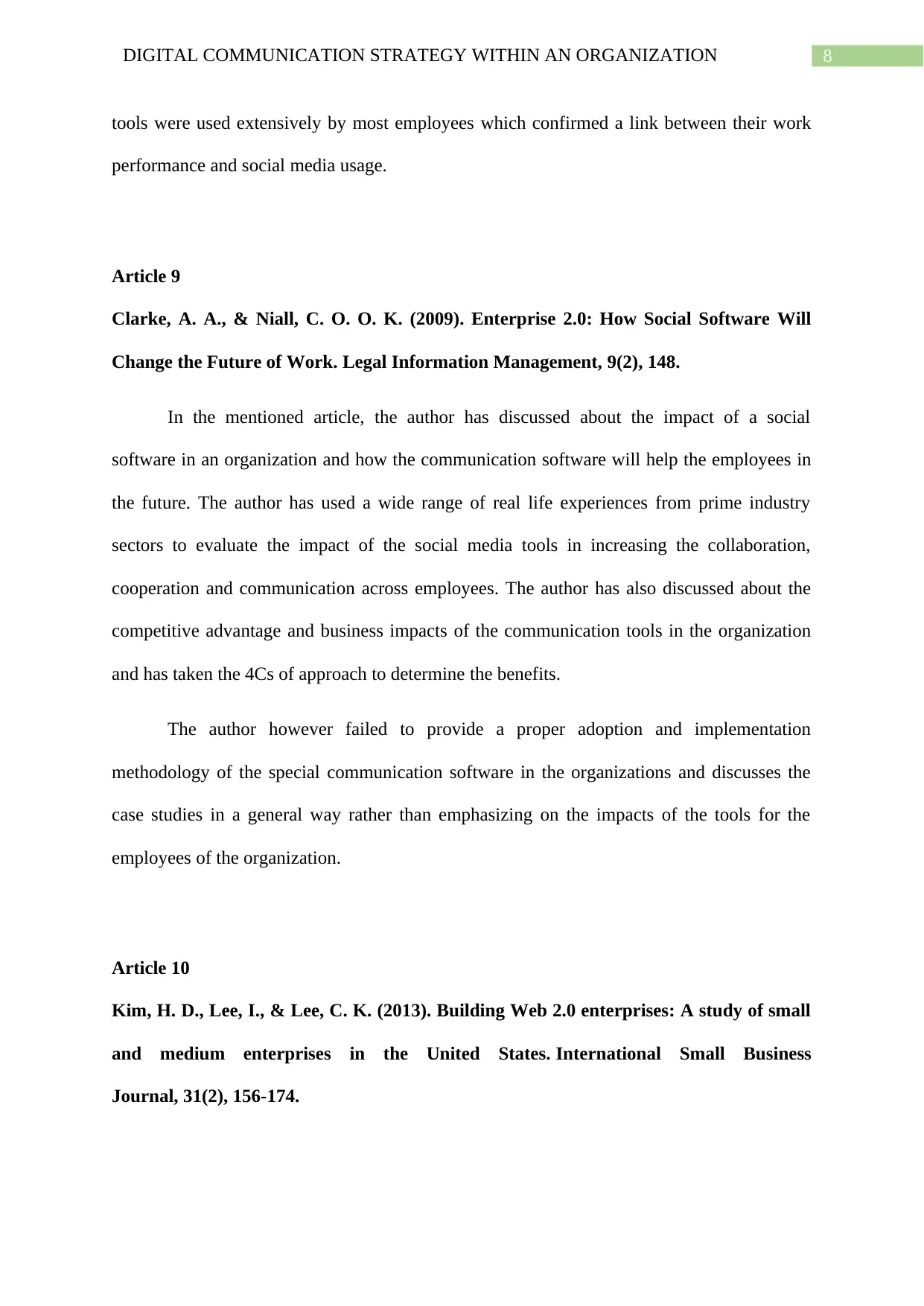
8DIGITAL COMMUNICATION STRATEGY WITHIN AN ORGANIZATION
tools were used extensively by most employees which confirmed a link between their work
performance and social media usage.
Article 9
Clarke, A. A., & Niall, C. O. O. K. (2009). Enterprise 2.0: How Social Software Will
Change the Future of Work. Legal Information Management, 9(2), 148.
In the mentioned article, the author has discussed about the impact of a social
software in an organization and how the communication software will help the employees in
the future. The author has used a wide range of real life experiences from prime industry
sectors to evaluate the impact of the social media tools in increasing the collaboration,
cooperation and communication across employees. The author has also discussed about the
competitive advantage and business impacts of the communication tools in the organization
and has taken the 4Cs of approach to determine the benefits.
The author however failed to provide a proper adoption and implementation
methodology of the special communication software in the organizations and discusses the
case studies in a general way rather than emphasizing on the impacts of the tools for the
employees of the organization.
Article 10
Kim, H. D., Lee, I., & Lee, C. K. (2013). Building Web 2.0 enterprises: A study of small
and medium enterprises in the United States. International Small Business
Journal, 31(2), 156-174.
tools were used extensively by most employees which confirmed a link between their work
performance and social media usage.
Article 9
Clarke, A. A., & Niall, C. O. O. K. (2009). Enterprise 2.0: How Social Software Will
Change the Future of Work. Legal Information Management, 9(2), 148.
In the mentioned article, the author has discussed about the impact of a social
software in an organization and how the communication software will help the employees in
the future. The author has used a wide range of real life experiences from prime industry
sectors to evaluate the impact of the social media tools in increasing the collaboration,
cooperation and communication across employees. The author has also discussed about the
competitive advantage and business impacts of the communication tools in the organization
and has taken the 4Cs of approach to determine the benefits.
The author however failed to provide a proper adoption and implementation
methodology of the special communication software in the organizations and discusses the
case studies in a general way rather than emphasizing on the impacts of the tools for the
employees of the organization.
Article 10
Kim, H. D., Lee, I., & Lee, C. K. (2013). Building Web 2.0 enterprises: A study of small
and medium enterprises in the United States. International Small Business
Journal, 31(2), 156-174.
⊘ This is a preview!⊘
Do you want full access?
Subscribe today to unlock all pages.

Trusted by 1+ million students worldwide
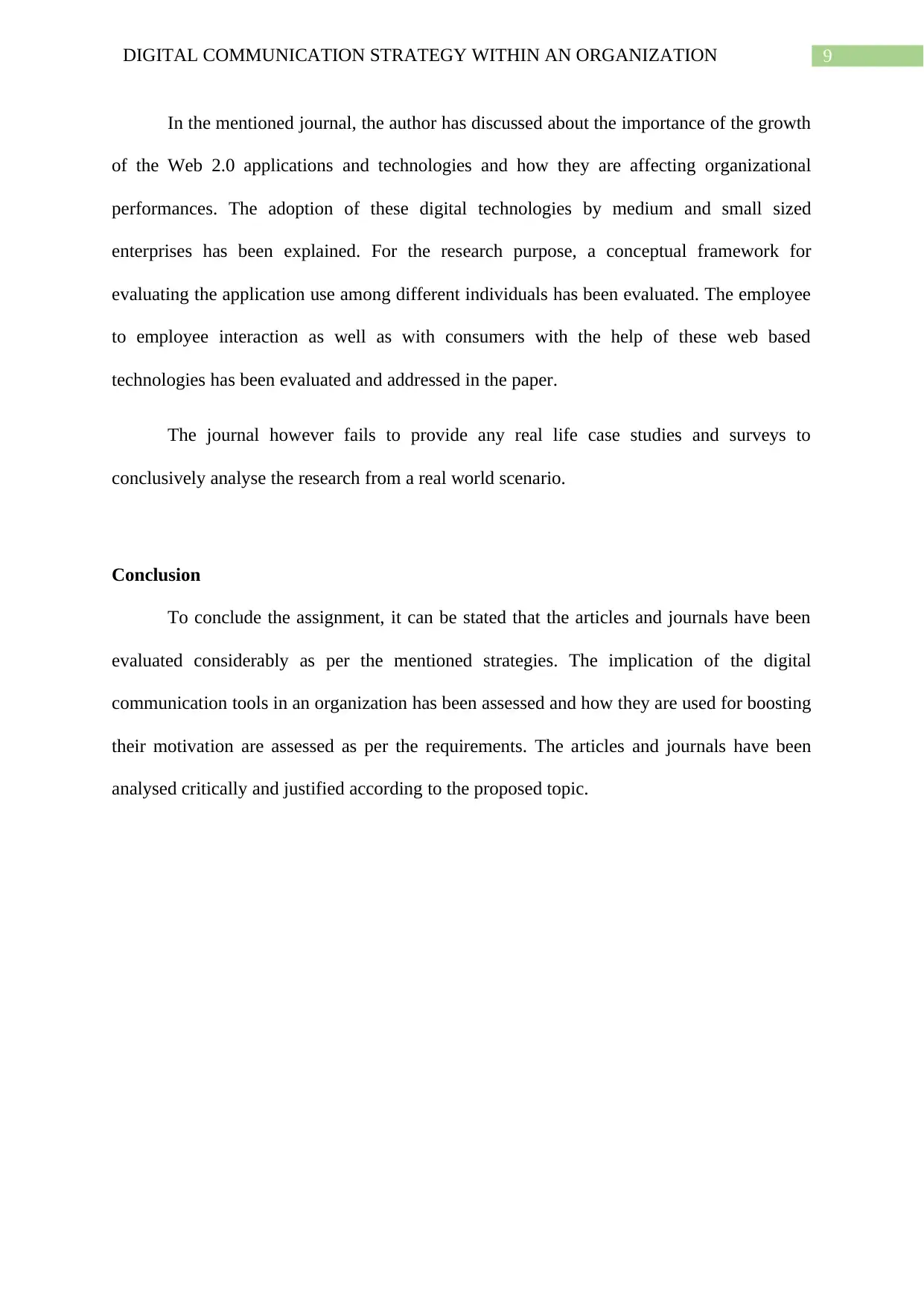
9DIGITAL COMMUNICATION STRATEGY WITHIN AN ORGANIZATION
In the mentioned journal, the author has discussed about the importance of the growth
of the Web 2.0 applications and technologies and how they are affecting organizational
performances. The adoption of these digital technologies by medium and small sized
enterprises has been explained. For the research purpose, a conceptual framework for
evaluating the application use among different individuals has been evaluated. The employee
to employee interaction as well as with consumers with the help of these web based
technologies has been evaluated and addressed in the paper.
The journal however fails to provide any real life case studies and surveys to
conclusively analyse the research from a real world scenario.
Conclusion
To conclude the assignment, it can be stated that the articles and journals have been
evaluated considerably as per the mentioned strategies. The implication of the digital
communication tools in an organization has been assessed and how they are used for boosting
their motivation are assessed as per the requirements. The articles and journals have been
analysed critically and justified according to the proposed topic.
In the mentioned journal, the author has discussed about the importance of the growth
of the Web 2.0 applications and technologies and how they are affecting organizational
performances. The adoption of these digital technologies by medium and small sized
enterprises has been explained. For the research purpose, a conceptual framework for
evaluating the application use among different individuals has been evaluated. The employee
to employee interaction as well as with consumers with the help of these web based
technologies has been evaluated and addressed in the paper.
The journal however fails to provide any real life case studies and surveys to
conclusively analyse the research from a real world scenario.
Conclusion
To conclude the assignment, it can be stated that the articles and journals have been
evaluated considerably as per the mentioned strategies. The implication of the digital
communication tools in an organization has been assessed and how they are used for boosting
their motivation are assessed as per the requirements. The articles and journals have been
analysed critically and justified according to the proposed topic.
Paraphrase This Document
Need a fresh take? Get an instant paraphrase of this document with our AI Paraphraser
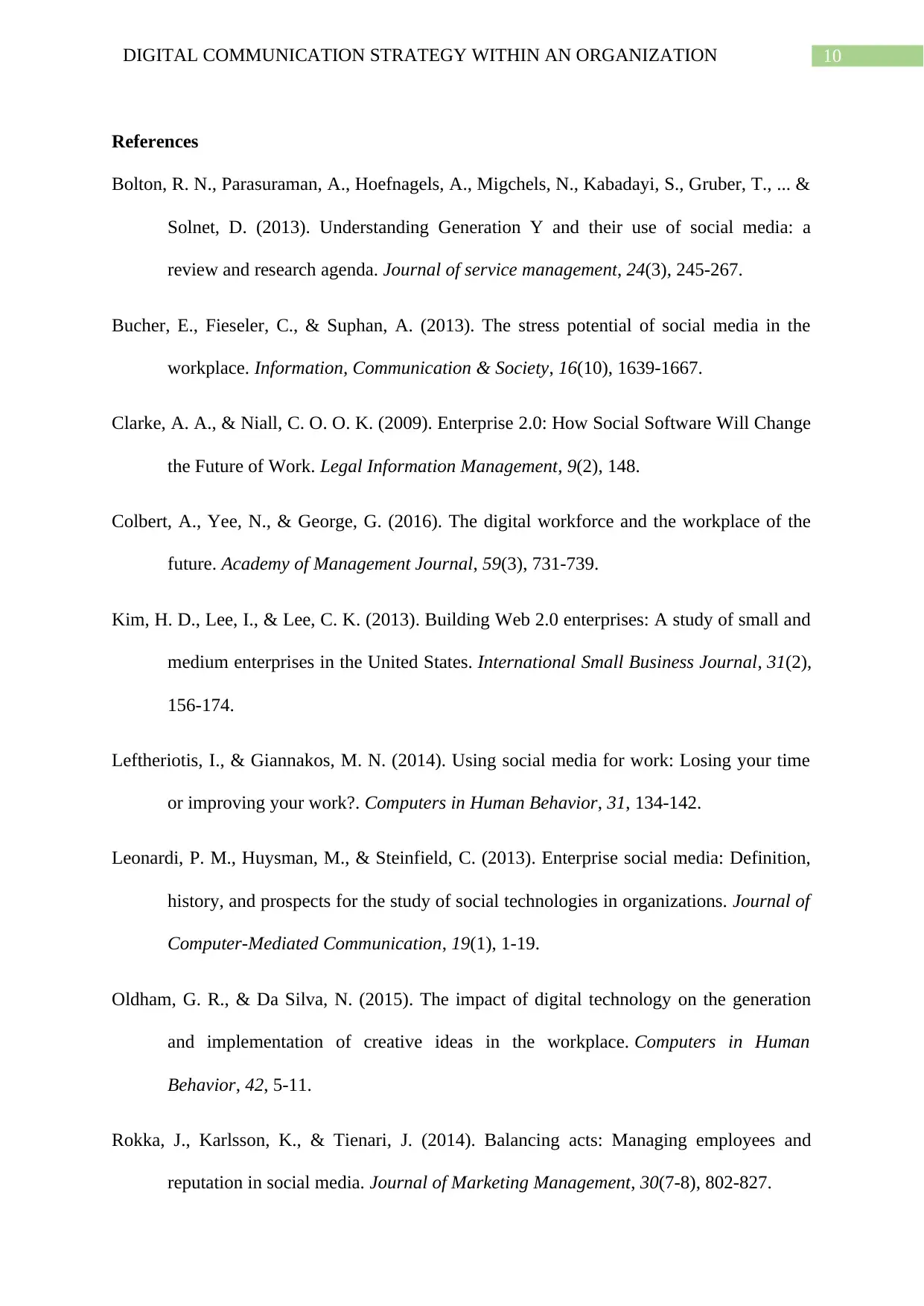
10DIGITAL COMMUNICATION STRATEGY WITHIN AN ORGANIZATION
References
Bolton, R. N., Parasuraman, A., Hoefnagels, A., Migchels, N., Kabadayi, S., Gruber, T., ... &
Solnet, D. (2013). Understanding Generation Y and their use of social media: a
review and research agenda. Journal of service management, 24(3), 245-267.
Bucher, E., Fieseler, C., & Suphan, A. (2013). The stress potential of social media in the
workplace. Information, Communication & Society, 16(10), 1639-1667.
Clarke, A. A., & Niall, C. O. O. K. (2009). Enterprise 2.0: How Social Software Will Change
the Future of Work. Legal Information Management, 9(2), 148.
Colbert, A., Yee, N., & George, G. (2016). The digital workforce and the workplace of the
future. Academy of Management Journal, 59(3), 731-739.
Kim, H. D., Lee, I., & Lee, C. K. (2013). Building Web 2.0 enterprises: A study of small and
medium enterprises in the United States. International Small Business Journal, 31(2),
156-174.
Leftheriotis, I., & Giannakos, M. N. (2014). Using social media for work: Losing your time
or improving your work?. Computers in Human Behavior, 31, 134-142.
Leonardi, P. M., Huysman, M., & Steinfield, C. (2013). Enterprise social media: Definition,
history, and prospects for the study of social technologies in organizations. Journal of
Computer-Mediated Communication, 19(1), 1-19.
Oldham, G. R., & Da Silva, N. (2015). The impact of digital technology on the generation
and implementation of creative ideas in the workplace. Computers in Human
Behavior, 42, 5-11.
Rokka, J., Karlsson, K., & Tienari, J. (2014). Balancing acts: Managing employees and
reputation in social media. Journal of Marketing Management, 30(7-8), 802-827.
References
Bolton, R. N., Parasuraman, A., Hoefnagels, A., Migchels, N., Kabadayi, S., Gruber, T., ... &
Solnet, D. (2013). Understanding Generation Y and their use of social media: a
review and research agenda. Journal of service management, 24(3), 245-267.
Bucher, E., Fieseler, C., & Suphan, A. (2013). The stress potential of social media in the
workplace. Information, Communication & Society, 16(10), 1639-1667.
Clarke, A. A., & Niall, C. O. O. K. (2009). Enterprise 2.0: How Social Software Will Change
the Future of Work. Legal Information Management, 9(2), 148.
Colbert, A., Yee, N., & George, G. (2016). The digital workforce and the workplace of the
future. Academy of Management Journal, 59(3), 731-739.
Kim, H. D., Lee, I., & Lee, C. K. (2013). Building Web 2.0 enterprises: A study of small and
medium enterprises in the United States. International Small Business Journal, 31(2),
156-174.
Leftheriotis, I., & Giannakos, M. N. (2014). Using social media for work: Losing your time
or improving your work?. Computers in Human Behavior, 31, 134-142.
Leonardi, P. M., Huysman, M., & Steinfield, C. (2013). Enterprise social media: Definition,
history, and prospects for the study of social technologies in organizations. Journal of
Computer-Mediated Communication, 19(1), 1-19.
Oldham, G. R., & Da Silva, N. (2015). The impact of digital technology on the generation
and implementation of creative ideas in the workplace. Computers in Human
Behavior, 42, 5-11.
Rokka, J., Karlsson, K., & Tienari, J. (2014). Balancing acts: Managing employees and
reputation in social media. Journal of Marketing Management, 30(7-8), 802-827.
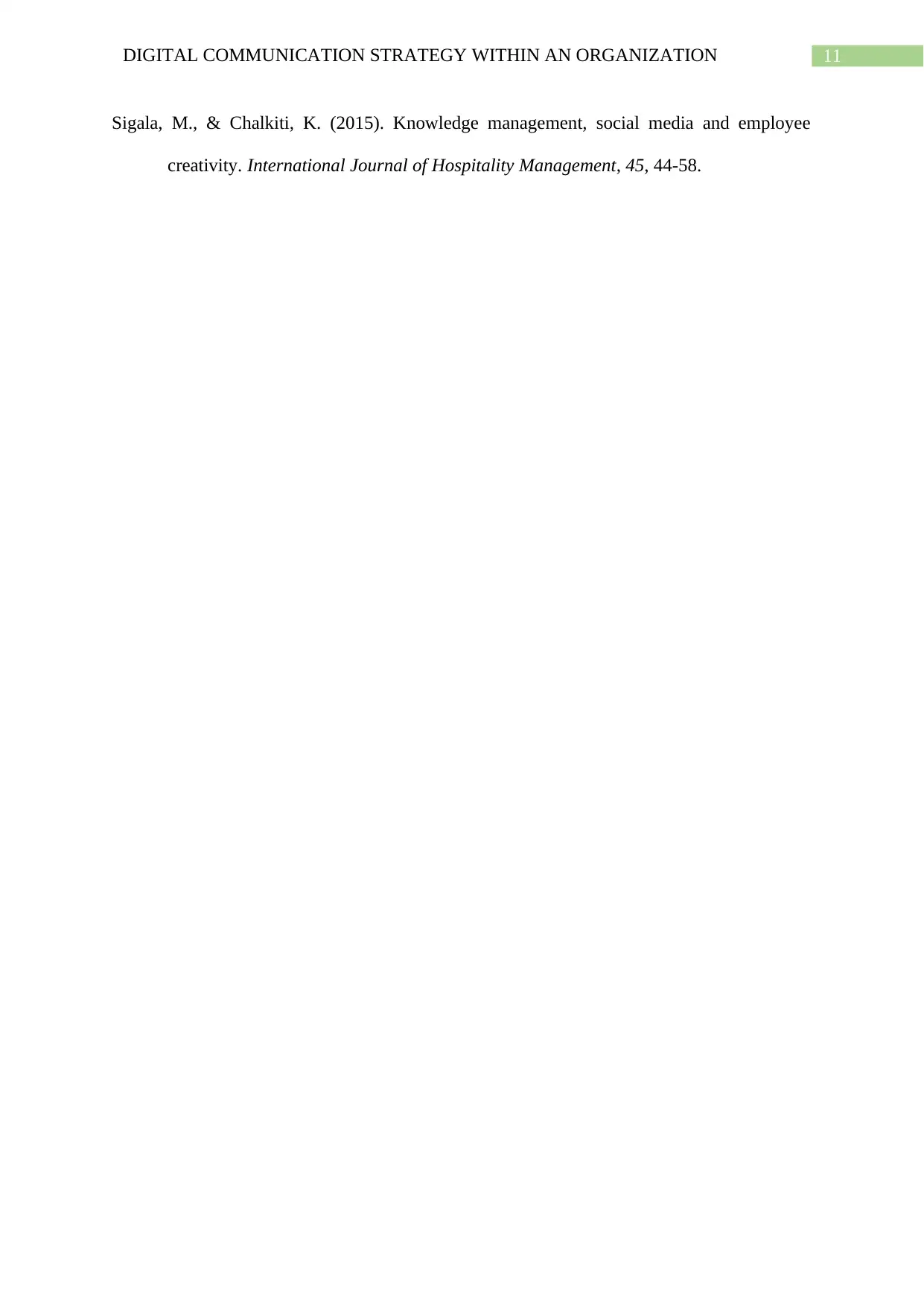
11DIGITAL COMMUNICATION STRATEGY WITHIN AN ORGANIZATION
Sigala, M., & Chalkiti, K. (2015). Knowledge management, social media and employee
creativity. International Journal of Hospitality Management, 45, 44-58.
Sigala, M., & Chalkiti, K. (2015). Knowledge management, social media and employee
creativity. International Journal of Hospitality Management, 45, 44-58.
⊘ This is a preview!⊘
Do you want full access?
Subscribe today to unlock all pages.

Trusted by 1+ million students worldwide
1 out of 12
Related Documents
Your All-in-One AI-Powered Toolkit for Academic Success.
+13062052269
info@desklib.com
Available 24*7 on WhatsApp / Email
![[object Object]](/_next/static/media/star-bottom.7253800d.svg)
Unlock your academic potential
Copyright © 2020–2025 A2Z Services. All Rights Reserved. Developed and managed by ZUCOL.





